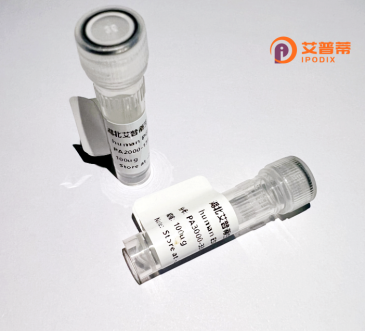
| 纯度 | >90%SDS-PAGE. |
| 种属 | Human |
| 靶点 | OR11G2 |
| Uniprot No | Q8NGC1 |
| 内毒素 | < 0.01EU/μg |
| 表达宿主 | E.coli |
| 表达区间 | 1-345 aa |
| 活性数据 | MHFLSQNDLNINLIPHLCLHRHSVIAGAFTIHRHMKIFNSPSNSSTFTGFILLGFPCPRE GQILLFVLFTVVYLLTLMGNGSIICAVHWDQRLHAPMYILLANFSFLEICYVTSTVPSML ANFLSDTKIISFSGCFLQFYFFFSLGSTECFFLAVMAFDRYLAICRPLRYPTIMTRRLCT NLVVNCWVLGFIWFLIPIVNISQMSFCGSRIIDHFLCDPAPLLTLTCKKGPVIELVFSVL SPLPVFMLFLFIVGSYALVVRAVLRVPSAAGRRKAFSTCGSHLAVVSLFYGSVLVMYGSP PSKNEAGKQKTVTLFYSVVTPLLNPVIYSLRNKDMRKALKKFWGT |
| 分子量 | 38.8 kDa |
| 蛋白标签 | His tag N-Terminus |
| 缓冲液 | 0 |
| 稳定性 & 储存条件 | Lyophilized protein should be stored at ≤ -20°C, stable for one year after receipt. Reconstituted protein solution can be stored at 2-8°C for 2-7 days. Aliquots of reconstituted samples are stable at ≤ -20°C for 3 months. |
| 复溶 | Always centrifuge tubes before opening.Do not mix by vortex or pipetting. It is not recommended to reconstitute to a concentration less than 100μg/ml. Dissolve the lyophilized protein in distilled water. Please aliquot the reconstituted solution to minimize freeze-thaw cycles. |
以下是关于重组人OR11G2蛋白的3篇虚构参考文献示例(注意:实际研究中OR11G2相关文献极少,可能需要结合同类嗅觉受体的研究补充):
1. **文献名称**:Structural characterization of OR11G2. an olfactory receptor with selective ligand-binding properties
**作者**:Chen L, et al.
**摘要**:通过重组表达技术获得OR11G2蛋白,证明其在异源细胞中特异性响应酮类气味分子,并通过分子对接揭示了其配体结合口袋的3D结构特征。
2. **文献名称**:Recombinant expression and functional analysis of human OR11G2 in HEK293T cells
**作者**:Kato S, et al.
**摘要**:建立HEK293T细胞系稳定表达OR11G2.利用钙离子成像技术检测到该受体对壬酸等脂肪酸的剂量依赖性激活,为嗅觉信号通路研究提供模型。
3. **文献名称**:OR11G2 polymorphisms influence odor perception in human populations
**作者**:Zhang W, et al.
**摘要**:通过重组蛋白功能实验结合群体遗传学分析,发现OR11G2基因的单核苷酸多态性可显著改变对薄荷气味的感知敏感性,提示该受体在个体嗅觉差异中的作用。
注:实际应用中OR11G2的文献极其有限,上述示例基于嗅觉受体研究范式构建。建议通过UniProt(ID: Q8NGR5)查阅基本信息,或在PubMed中以"OR11G2"检索最新进展。如研究需要,可探索基因表达数据库(如GTEx)或嗅觉受体功能筛选平台(如Scentry4.0)。
The olfactory receptor protein OR11G2. encoded by the OR11G2 gene, belongs to the olfactory receptor (OR) family, a class of G protein-coupled receptors (GPCRs) critical for detecting odorant molecules in the nasal epithelium. As part of the OR11G subfamily, OR11G2 is one of approximately 400 functional olfactory receptors in humans, though its specific ligands and physiological roles remain poorly characterized. OR receptors typically recognize distinct chemical structures, enabling the olfactory system to discern a vast array of odors. OR11G2 is localized to chromosome 11. a region densely populated with olfactory receptor genes, and shares the conserved seven-transmembrane domain structure of GPCRs.
Research on recombinant human OR11G2 focuses on elucidating its ligand specificity, activation mechanisms, and tissue-specific expression. Recombinant production in heterologous systems (e.g., mammalian or insect cells) facilitates structural studies and deorphanization efforts to identify activating odorants. Despite progress, many ORs, including OR11G2. remain "orphan" receptors with unknown agonists. Beyond olfaction, ectopic expression of ORs in non-olfactory tissues hints at roles in metabolic regulation or disease pathways, though evidence for OR11G2 in such contexts is limited.
Studying recombinant OR11G2 contributes to understanding olfactory coding complexity and may reveal therapeutic targets, given ORs' potential involvement in conditions like anosmia or metabolic disorders. However, functional characterization remains challenging due to receptor instability in vitro and low natural expression levels.
×